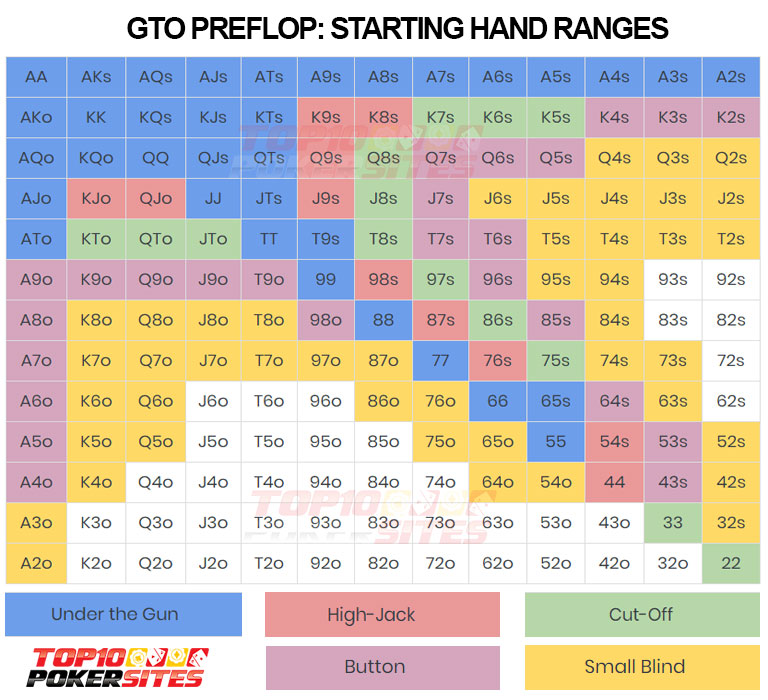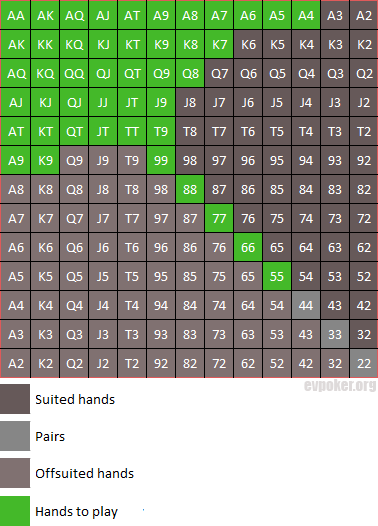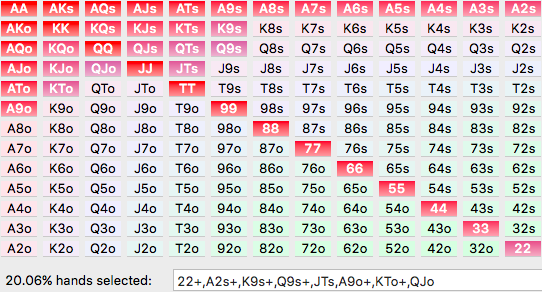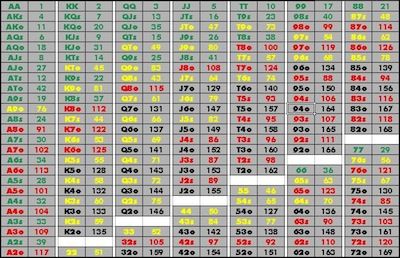Poker Starting Hand Chart No Limit
- Poker Hands Order Chart
- Poker Hands Chart
- Poker Starting Hand Chart No Limit Balance
- Limit Holdem Starting Hand Chart
The former Ongame poker site “Pokerroom” (now part of Bwin) had published an analysis of over 120 million starting hands on its website. The figures were derived from cash games (heads up, shorthanded, full ring tables). This table comes from the book Hold 'em Poker for Advanced Players by David Sklansky and Mason Malmuth. This is a strategy book for limit Hold'em, but the starting hand groups do have some practical use in no limit Hold'em. What is the Sklansky and Malmuth starting hands table? The table is a general ranking of hands in Texas Hold'em.
In the poker game of Texas hold 'em, a starting hand consists of two hole cards, which belong solely to the player and remain hidden from the other players. Five community cards are also dealt into play. Betting begins before any of the community cards are exposed, and continues throughout the hand. The player's 'playing hand', which will be compared against that of each competing player, is the best 5-card poker hand available from his two hole cards and the five community cards. Unless otherwise specified, here the term hand applies to the player's two hole cards, or starting hand.
Essentials[edit]
There are 1326 distinct possible combinations of two hole cards from a standard 52-card deck in hold 'em, but since suits have no relative value in this poker variant, many of these hands are identical in value before the flop. For example, A♥J♥ and A♠J♠ are identical in value, because each is a hand consisting of an ace and a jack of the same suit.
Therefore, there are 169 non-equivalent starting hands in hold 'em, which is the sum total of : 13 pocket pairs, 13 × 12 / 2 = 78 suited hands and 78 unsuited hands (13 + 78 + 78 = 169).
These 169 hands are not equally likely. Hold 'em hands are sometimes classified as having one of three 'shapes':
- Pairs, (or 'pocket pairs'), which consist of two cards of the same rank (e.g. 9♠9♣). One hand in 17 will be a pair, each occurring with individual probability 1/221 (P(pair) = 3/51 = 1/17).
- Alternative means of making this calculation
- First Step
- As confirmed above.
Poker Hands Order Chart
- There are 1326 possible combination of opening hand.
- Second Step
- There are 6 different combos of each pair. 9h9c, 9h9s, 9h9d, 9c9s, 9c9d, 9d9s. Therefore, there are 78 possible combinations of pocket pairs (6 multiplied by 13 i.e. 22-AA)
- To calculate the odds of being dealt a pair
- 78 (the number of any particular pair being dealt. As above) divided by 1326 (possible opening hands)
- 78/1326 = 0.058 or 5.8%
- Suited hands, which contain two cards of the same suit (e.g. A♣6♣). 23.5% of all starting hands are suited.
Probability of first card is 1.0 (any of the 52 cards)Probability of second hand suit matching the first:There are 13 cards per suit, and one is in your hand leaving 12 remaining of the 51 cards remaining in the deck. 12/51=.2353 or 23.5%
- Offsuit hands, which contain two cards of a different suit and rank (e.g. K♠J♥). 70.6% of all hands are offsuit hands
Offsuit pairs = 78Other offsuit hands = 936
It is typical to abbreviate suited hands in hold 'em by affixing an 's' to the hand, as well as to abbreviate non-suited hands with an 'o' (for offsuit). That is,
- QQ represents any pair of queens,
- KQ represents any king and queen,
- AKo represents any ace and king of different suits, and
- JTs represents any jack and ten of the same suit.
Limit hand rankings[edit]
Some notable theorists and players have created systems to rank the value of starting hands in limit Texas hold'em. These rankings do not apply to no limit play.
Sklansky hand groups[edit]
David Sklansky and Mason Malmuth[1] assigned in 1999 each hand to a group, and proposed all hands in the group could normally be played similarly. Stronger starting hands are identified by a lower number. Hands without a number are the weakest starting hands. As a general rule, books on Texas hold'em present hand strengths starting with the assumption of a nine or ten person table. The table below illustrates the concept:
Chen formula[edit]
The 'Chen Formula' is a way to compute the 'power ratings' of starting hands that was originally developed by Bill Chen.[2]
- Highest Card
- Based on the highest card, assign points as follows:
- Ace = 10 points, K = 8 points, Q = 7 points, J = 6 points.
- 10 through 2, half of face value (10 = 5 points, 9 = 4.5 points, etc.)
- Pairs
- For pairs, multiply the points by 2 (AA=20, KK=16, etc.), with a minimum of 5 points for any pair. 55 is given an extra point (i.e., 6).
- Suited
- Add 2 points for suited cards.

- Closeness
- Subtract 1 point for 1 gappers (AQ, J9)
- 2 points for 2 gappers (J8, AJ).
- 4 points for 3 gappers (J7, 73).
- 5 points for larger gappers, including A2 A3 A4

- Add an extra point if connected or 1-gap and your highest card is lower than Q (since you then can make all higher straights)
Phil Hellmuth's: 'Play Poker Like the Pros'[edit]
Phil Hellmuth's 'Play Poker Like the Pros' book published in 2003.
| Tier | Hands | Category |
|---|---|---|
| 1 | AA, KK, AKs, QQ, AK | Top 12 Hands |
| 2 | JJ, TT, 99 | |
| 3 | 88, 77, AQs, AQ | |
| 4 | 66, 55, 44, 33, 22, AJs, ATs, A9s, A8s | Majority Play Hands |
| 5 | A7s, A6s, A5s, A4s, A3s, A2s, KQs, KQ | |
| 6 | QJs, JTs, T9s, 98s, 87s, 76s, 65s | Suited Connectors |
Statistics based on real online play[edit]
Statistics based on real play with their associated actual value in real bets.[3]
| Tier | Hands | Expected Value |
|---|---|---|
| 1 | AA, KK, QQ, JJ, AKs | 2.32 - 0.78 |
| 2 | AQs, TT, AK, AJs, KQs, 99 | 0.59 - 0.38 |
| 3 | ATs, AQ, KJs, 88, KTs, QJs | 0.32 - 0.20 |
| 4 | A9s, AJ, QTs, KQ, 77, JTs | 0.19 - 0.15 |
| 5 | A8s, K9s, AT, A5s, A7s | 0.10 - 0.08 |
| 6 | KJ, 66, T9s, A4s, Q9s | 0.08 - 0.05 |
| 7 | J9s, QJ, A6s, 55, A3s, K8s, KT | 0.04 - 0.01 |
| 8 | 98s, T8s, K7s, A2s | 0.00 |
| 9 | 87s, QT, Q8s, 44, A9, J8s, 76s, JT | (-) 0.02 - 0.03 |
Nicknames for starting hands[edit]
In poker communities, it is common for hole cards to be given nicknames. While most combinations have a nickname, stronger handed nicknames are generally more recognized, the most notable probably being the 'Big Slick' - Ace and King of the same suit, although an Ace-King of any suit combination is less occasionally referred to as an Anna Kournikova, derived from the initials AK and because it 'looks really good but rarely wins.'[4][5] Hands can be named according to their shapes (e.g., paired aces look like 'rockets', paired jacks look like 'fish hooks'); a historic event (e.g., A's and 8's - dead man's hand, representing the hand held by Wild Bill Hickok when he was fatally shot in the back by Jack McCall in 1876); many other reasons like animal names, alliteration and rhyming are also used in nicknames.
Notes[edit]
- ^David Sklansky and Mason Malmuth (1999). Hold 'em Poker for Advanced Players. Two Plus Two Publications. ISBN1-880685-22-1
- ^Hold'em Excellence: From Beginner to Winner by Lou Krieger, Chapter 5, pages 39 - 43, Second Edition
- ^http://www.pokerroom.com/poker/poker-school/ev-stats/total-stats-by-card/[dead link]
- ^Aspden, Peter (2007-05-19). 'FT Weekend Magazine - Non-fiction: Stakes and chips Las Vegas and the internet have helped poker become the biggest game in town'. Financial Times. Retrieved 2010-01-10.
- ^Martain, Tim (2007-07-15). 'A little luck helps out'. Sunday Tasmanian. Retrieved 2010-01-10.

The Hutchison Point System for Texas Holdem is an excellent beginners guide to starting hand selection. While learning this system will not make you a favorite at next year's World Series of Poker, it will most definitely give the new Texas Holdem player an idea of the value of the pocket cards he or she is holding.
Why is this important? The main reason players lose money in poker is because they play too many cards. This system limits the number of starting hands to cards that have a much better than average chance of winning. While this guide will not help you with many aspects of Holdem, including flop, turn and river play, it will simplify the process of which cards to hang onto and which to dump before the flop. This, in my opinion is the biggest challenge for players new to the game, and thusly a good edition for the general strategy section.
The Hutchison Point System
After being dealt your pocket pairs, assign the following values:
Ace = 16 points
King = 14 points
Queen = 13 points
Jack = 12 points
Ten = 11 points
All other cards are worth their “face value.” (ie. 5 of hearts is worth 5 points, etc)
Additional Qualifiers:

Pocket Pair = +10
Same Suit = +4
Connected = +3 (ie. 9-10, or Jack-Queen. No gaps.)
One Card Gap = +2 (ie. Jack-King)
Two Card Gap = +1 (ie. Jack-Ace)
What the numbers mean:
If your total is:
30+ Premium cards, that can be played from any position, if there are no raises.
27+ These cards can be played from Middle or Late position, provided there are no raises.
25+ Should only be played from late position, if there have been no raises.
To raise or call a raise, you should have a point total of:
Poker Hands Chart
34+ In early position
31+ In middle position
29+ In late position
Examples
Poker Starting Hand Chart No Limit Balance
Ace-Ace: That would be 16+16 for the two aces, and an additional +10 for their being a pocket pair. Thats a total of 42 points. Obviously strong and playable!
Queen-Jack suited: 13 + 12 for the cards, +4 for suited, +3 since they are connected. A total of 32. You could call the big blind with this hand in any position, but if there is a raise, you should only call the raise in middle or late position.
10-6 suited: 11 + 9 for the cards, +4 suited = 24 points. Fold them! This is a perfect example of a hand that many beginning players will call with, hoping for a flush or miracle straight draw. They will almost always lose, and even when the straight or flush is made, there is good chance that a higher straight or flush will take the pot.
Hutchison Statistics
The creator of this formula states that in simulations, only playing 30 point hands yielded a win rate of 17% in a 10 handed game where every hand is played to the river. Obviously, if you played every random hand, you would have an average win rate of only 10%. Thats a 70% increase.

In conclusion, one should note that the game of Texas Holdem is extremely complex, and a simple formula such as this certainly does not do justice to all of the other variables that determine winning and losing players. But even given the complexity of the game, it cannot be emphasized enough that the #1 mistake that beginners make is playing too many hands. If you have only lost money so far in Holdem, this is almost certainly at the root of the problem!
The Hutchison Point System makes starting hand choices much easier to decide upon and should result in a much healthier bank roll for the beginner in low limit holdem.
Limit Holdem Starting Hand Chart
For the full article and disclaimers by Edward Hutchison, click the following link: